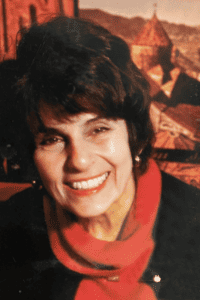LUCY DER MANUELIAN (July 7, 1928 – September 20, 2021)

Archbishop Anoushavan, Prelate, and the Executive and Religious Councils learned with sorrow of the passing of Lucy Der Manuelian, who taught Armenian art and architecture at Tufts University and was a guest lecturer at various programs of the Eastern Prelacy.
Dr. Der Manuelian passed away at her home in Belmont, Massachusetts, on Monday, Sept. 20. She was the founder and first occupant of the Arthur H. Dadian and Ara T. Oztemel Chair of Armenian Art in the Department of the History of Art and Architecture at Tufts. The Tufts chair is the first and only endowed professorship of Armenian art outside the Republic of Armenia. This would not have been possible without Dr. Der Manuelian’s indefatigable work towards its creation and the financial support of attorney Arthur H. Dadian and businessman Ara T. Oztemel. Dr. Der Manuelian retired in 2006.
“She was educated at Harvard, and, after a twenty-year hiatus from academia in which she raised two children, received her Ph.D. at Boston University in 1980,” says in an obituary note Prof. Christina Maranci, who succeeded Dr. Der Manuelian at the Tufts chair. Her dissertation was about the medieval sculptural program of Geghard. It was “the first serious English-language monograph on that site,” Prof. Maranci says. “Her dissertation is also widely considered to be the first American dissertation dedicated to Armenian art.”
Dr. Der Manuelian also contributed to many scholarly projects, including the Dictionary of the Middle Ages (1982-1989) and Grove Dictionary of Art (now Oxford Art Online). She was an author and researcher for the massive microfiche work known as Armenian Architecture (Zug: Inter Documentation, c. 1980-c.1990). She contributed articles to several important Armenological volumes, including Medieval Armenian Culture (Thomas Samuelian, ed., Chico: Scholars Press, 1984). In addition to work on Armenian architecture and sculpture, Lucy published widely on a variety of topics within Armenian art. “Among her most noted projects are her publications on carpets, including the exhibition catalogue, Weavers, Merchants, and Kings: The Inscribed Rugs of Armenia- Kimbell Art Museum (Forth Worth, Kimbell Art Museum 1984) which provided a crucial English-language scholarly foundation for the history of Armenian rug weaving,” Prof. Maranci says.
“Lucy was fearless, physically and psychologically,” Prof. Maranci recalls. “Before the era of drones, she hung out of helicopters to take good aerial shots of monasteries and churches. At the height of the Soviet period, the KGB suspected that she was a spy because of all her travel and photography. One night, they visited her in Yerevan, and, to avoid handing over the film, Lucy hid it inside her dress, daring them to manhandle her. Art history won and we have the photographs.”
Archbishop Anoushavan and the Religious and Lay Councils extend their condolences to Dr. Der Manuelian’s family members and loved ones. May God illuminate her soul.
